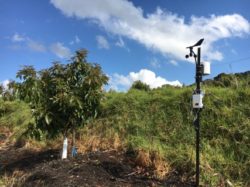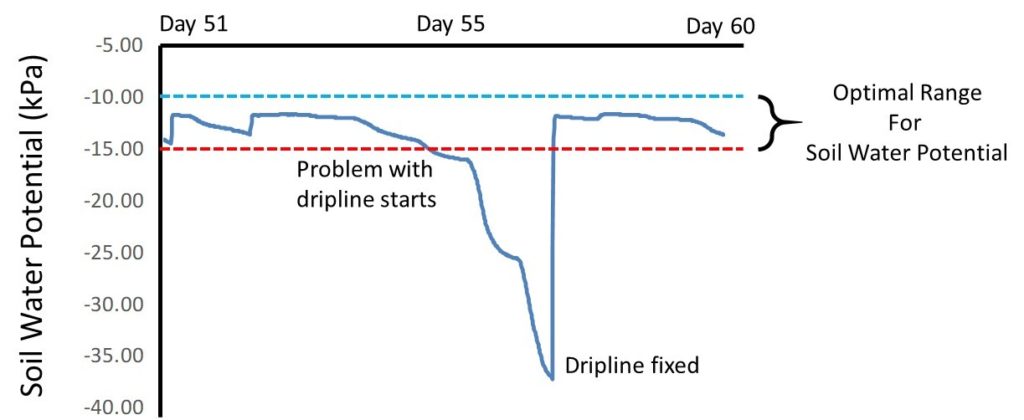New tensiometer-style sensor for avocado growers

A new, tensiometer-style sensor is improving irrigation management and saving time and costs for avocado growers.
Irrigation monitoring and scheduling often relies on tensiometers – sensors that can measure soil water potential. Tensiometers are a favourite among avocado growers but they come with a huge problem: they are extremely tedious and odious to maintain.
A new sensor, based on advanced scientific research, is rapidly being adopted by avocado growers and is quickly making the old tensiometer redundant. The new sensor, called an TEROS 21 Soil Water Potential Sensor (formally known as the MPS-6 sensor) has made tensiometer-style measurements entirely maintenance free. This new technology will save growers on costs as well as providing more time to focus on other activities.
TEROS 21 sensor versus tensiometers
 The TEROS 21 sensor, available from Edaphic Scientific, measures the wetness of the soil in a similar manner to a tensiometer. That is, the TEROS 21 measures soil matric water potential. Just like a tensiometer, a value near zero indicates a saturated soil. More negative kPa values, or higher centibar values, indicate a drying soil. Typically, soil water potential for avocado is maintained around -10 to -15 kPa (10 to 15 centibar). This range of measurement is ideal for tensiometers and the TEROS 21 sensor.
The TEROS 21 sensor, available from Edaphic Scientific, measures the wetness of the soil in a similar manner to a tensiometer. That is, the TEROS 21 measures soil matric water potential. Just like a tensiometer, a value near zero indicates a saturated soil. More negative kPa values, or higher centibar values, indicate a drying soil. Typically, soil water potential for avocado is maintained around -10 to -15 kPa (10 to 15 centibar). This range of measurement is ideal for tensiometers and the TEROS 21 sensor.
And that is where the similarities end. The biggest differences between the TEROS 21 and a tensiometer are ease of installation and ongoing maintenance. During installation, a water column within the reservoir tube of the tensiometer must be filled with water (which creates the tension with the soil matrix). Importantly, this water column must be filled carefully to avoid air bubbles. In practice, this can be extremely difficult and often requires a vacuum pump. The presence of even a single, small air bubble can adversely affect tensiometer accuracy.
The ongoing maintenance is also related to this water column. For accurate measurements, the water column in a tensiometer must always be full and it must never have air bubbles. Depending weather conditions and soil type, it may be necessary to refill the water column every day (e.g. sandy soils) or a few times a week (e.g. loamy or clay soils). In other words, tensiometers require significant time, labour and resources for accurate measurements and can be an ongoing source of on-farm costs.
The TEROS 21, in contrast, takes a few minutes to install and there is no ongoing maintenance. The TEROS 21 is better than tensiometers because it does not need a water column. This means that during installation the sensor just needs to be placed at the soil depth of interest. Once buried in the soil, there is no need for any further attendance on the sensor. The TEROS 21 is a digital, low-power sensor so is also ideal for internet access and wireless sensor networks such as LoRa WAN.
case study: how the TEROS 21improves avocado irrigation management
On the Comboyne Plateau, on the mid-north coast of New South Wales, Australia, an avocado grower needed to maintain his soil water potential between -10 kPa and -15 kPa. The grower regularly travelled overseas, therefore he needed a sensor that was reliable and required no maintenance.
A series of TEROS 21 sensors were installed at 15 cm soil depth and were connected to the ZL6 Telemetry Logger. Installation of the TEROS 21 took less than 5 minutes per sensor and, once installed, have not needed any further maintenance. The ZL6 has an inbuilt solar panel and battery, so there was no further requirement for maintaining a power source. The ZL6 also has an inbuilt modem and data could be accessed on the internet via the ZENTRA Cloud software platform. The ZL6 was ideal for this grower as it required no maintenance and he could access his data anytime, overseas, where he had an internet connection.
The TEROS 21 successfully measured soil water potential between -10 kPa and -15 kPa. The following graph shows 50 days’ worth of data where the avocado grower’s irrigation management was able to maintain an optimal soil water environment:
From around day 55, the soil water potential values dropped below -15 kPa. As can be seen in the next graph, the values were as dry as -40 kPa over a 4-day period. The avocado grower investigated the site and noted the irrigation drip line had been disturbed and was not providing water to the avocado tree. The line was fixed, and the soil water potential values returned to the optimal range between -10 and -15 kPa.
conclusion
The TEROS 21 Soil Water Potential Sensor is the latest technology that will improve grower’s irrigation management. The time and costs savings in not having to maintain old, tensiometers is a significant improvement in of itself. Coupled with the ability to easily integrate with IoT technology, the TEROS 21 Soil Water Potential Sensor is an ideal solution for irrigation monitoring.
further information
- Soil water potential sensors
- Access your data over the internet
- Why tensiometers and gypsum blocks are obsolete


